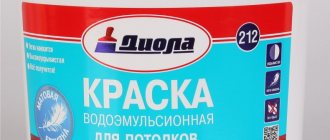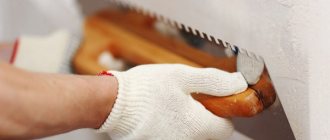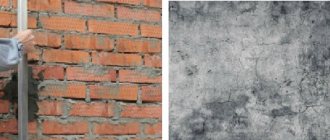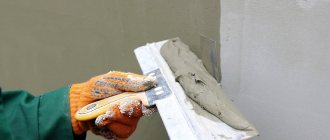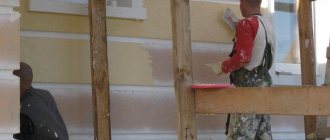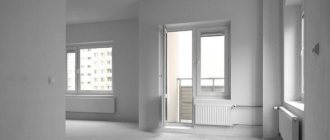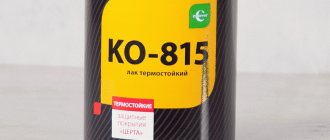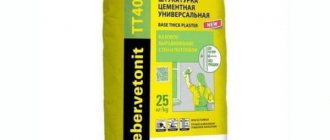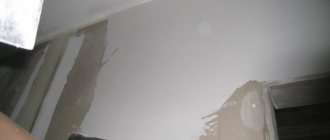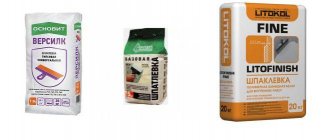Features of finishing putty
Finishing putty is a special composition that makes the surface of the walls uniform and complete. In order for the finishing work to be of high quality, it is necessary to strictly adhere to the execution technology.
The features of finish putty include the following qualities.
- The granules have a fine fraction.
- Snow white color.
- Gloss effect.
- Good adhesion.
The finish must be of good quality and meet certain criteria.
- The putty finish should be easy to apply and should not drag on the spatula.
- It should not flow down from the walls.
- A thin layer of finish should hide defects.
- There should be no cracks in the hardened putty.
- The color should be an even white shade without impurities.
Which is better?
Putty for finishing the surface of walls before gluing wallpaper can be purchased in two types:
Dry mixture
Ready solution
The advantages of dry formulations are as follows:
- long shelf life;
- frost resistance;
- low price;
- independent selection of the required volumes of the finished mixture and its thickness;
- There are universal options available for sale, suitable for starting and finishing surface treatment.
This type of product also has its disadvantages:
- additional time for preparing the building mixture;
- rapid drying of the solution and the impossibility of re-using it, which significantly limits the time it takes to complete the work and requires clear planning of the volume of material to be mixed;
- the ability to correctly calculate the proportions of water and powder composition for preparing the mixture, the presence of a mixer attachment to obtain a homogeneous mass of putty is required;
- difference in the shade of the material in different batches of the mixture.
The finished formulations are packaged in plastic containers of various sizes and are distinguished by a number of positive qualities:
- ease of application;
- homogeneity of composition and high plasticity;
- retains its qualities for a long time when stored in a tightly closed container;
- preferred for finishing, suitable for tinting and painting.
Disadvantages of the material:
- high cost;
- does not tolerate freezing during storage;
- difference in shades of composition from different batches.
Types of finishing putty
The finishing putty differs in composition; there are three types:
- Cement mixture. The cement-based putty finish is durable and moisture-resistant. It contains fine quartz sand, which allows you to achieve perfect smoothness. It is sold in liquid and dry form.
- Gypsum mixture. Gypsum finishing putty allows air to pass through well, allowing the surface to breathe. It is considered an environmentally friendly material, but at the same time, gypsum is afraid of moisture, so it cannot be used for painting.
- Polymer mixture. This is a modern type of finishing material that includes many components. It makes the surface durable and moisture-resistant, contains the smallest fractions that contribute to the ideal smoothness of the surface.
Finishing putties that you choose
Correcting minor defects after the initial leveling of the walls - this is the role of the finishing putty. With its help, walls are prepared directly for wallpaper and painting. An even and smooth surface is obtained due to the fine-grained nature of the finishing mixture. If you choose a grain size of 100 microns, you will get ideal walls for further painting.
The finishing putty is applied in 2 layers, then it is easily processed, since its strength is lower than that of the base material. The maximum thickness of the finishing putty layer should not exceed 5 mm. Just like the starting putty, the finishing putty can be based on cement, gypsum and polymer.
Finishing putty Knauf Rotband
Without much effort, you will achieve perfectly smooth walls for painting and wallpapering with the finishing gypsum putty “Knauf Rotband Finish”. Polymer additives ensure the absence of cracks on the surface and shrinkage after rapid drying. Such material can correct decent curvatures in walls.
Finishing putty Knauf Rotband
The putty is used for internal use in the preparation of surfaces made of concrete, plasterboard, and also plastered with gypsum and cement mixtures. Rotband finishing putty can be applied with a thickness of 0.2 to 5 mm.
Finishing putty “Prospectors”
The advantages of putty from for finishing work are high hiding power and whiteness of color /
Finishing putty Prospectors
Thanks to this, when preparing walls and ceilings with any surface - concrete, plaster, brick, you can save a lot on finishing putty: the minimum layer thickness can be only 0.3 cm. Modifying additives included in the mixture give the material high moisture resistance.
Finishing putty UNIS
The UNIS company suggests using highly plastic gypsum putty as a final finish before painting ceilings, which can be applied in a layer of 0.1 mm. UNIS putty mixture ensures easy sanding and ideal layer mixing.
Finishing ideal putty UNIS
The company's developers also presented a new product: finishing polymer putty UNIS LR Plus “White Pearl” with superplasticity properties, antibacterial additives and the ability to obtain a smooth and perfectly white surface.
Finishing putty application technology
The finishing putty must be applied to the surface finished with the starting putty. The thinner the finish layer, the better; it should be no more than three millimeters.
The next layer can be applied only after the previous one has dried. A large and a small spatula are used as a tool; the large spatula is used to cover wide surfaces, and the small spatula is used to cover hard-to-reach places.
When applying a new layer of putty, the direction of the spatula should be different each time.
- You need to run the tool over the surface several times to achieve perfect smoothness.
- When the surface is dry, you need to use sandpaper to grout.
- The putty must be applied immediately after stirring and preparing the composition, as it tends to dry out quickly.
If work is going slowly, it is best to dilute the putty in small portions. It is impossible to restore a dried composition by adding water.
Regulatory Requirements
- Is there a GOST for the production of putty??
Cement (as well as other building mixtures with a cement binder) are produced in accordance with GOST 31357-2007, gypsum putty mixtures are produced in accordance with GOST 31387-2008. For the convenience of the reader, I will present here the key requirements of the standards.
Cement mixtures
Any cement building mixtures must comply with GOST 31357-2007.
The document regulates:
- Humidity of the mixture. It should not exceed 0.3% for putties on a combined binder with an amount of cement not exceeding 80% of the total amount of binder, and 0.2% for mixtures with a large amount of Portland cement;
- The amount of aggregate with a fraction size higher than the maximum. It should not be more than half a percent. Estimating the amount of coarse aggregate is carried out extremely simply - by sifting through a sieve with the appropriate mesh size;
A simple aggregate size test.
- Water absorption after the finishing material reaches full strength. It should not be more than 15% for mixtures using a combined binder with less than 80% cement and more than 8% for mixtures with a large amount of cement;
- Adhesion to the base. The minimum permissible values are 0.4 MPa for exterior finishing and 0.25 for interior finishing;
- Packing method. Mixtures can be supplied in polyethylene bags, in multi-layer packaging made of kraft paper and in paper bags with polyethylene liners.
Typical packaging of cement mixtures.
Gypsum mixtures
Here are the standard requirements for gypsum mixtures:
- Humidity should not exceed 0.3% by weight;
- The maximum permissible aggregate fraction size is 0.2 mm, while the aggregate content of larger fractions should not exceed 0.3%;
- The beginning of setting should occur no earlier than 60 minutes from the moment the mixture is mixed;
In practice, long before setting begins, the mixture thickens and becomes unsuitable for application. The practical ceiling of its viability does not exceed 30-45 minutes.
That is why gypsum putty is prepared in small portions.
- After the putty has hardened, the tensile strength during bending should not be less than 1 MPa, and the compressive strength - less than 2 MPa;
- The adhesion strength of the hardened putty to the base must be equal to or exceed 0.3 MPa;
- The same types of bags can be used as packaging as for cement mixtures - polyethylene, made from multi-layer kraft paper and paper with polyethylene liners;
- The weight of one package should not exceed:
| Type of packaging | Maximum permissible weight |
| Plastic bag | 8 kg |
| Bag | 50 kg |
In practice, gypsum mixtures are sold packaged in 25-30 kg packages.
Selection of finishing putty
When choosing a finishing putty, it is important to follow the rule - start and finish must be from the same manufacturer. They mesh better with each other, maintaining continuity.
If the surface is porous, it is best to apply the finish with a primer, which will make the wall more solid and smooth. You should not save, as using cheap materials and saving on primer will affect the quality of the repair in a negative way.
Use the instructions on the finishing putty package to learn how to properly mix the mixture and maintain the required proportions.
- For bathrooms, baths and saunas, it is recommended to use cement putty. It perfectly resists moisture and is not afraid of water;
- Gypsum putty is used for residential premises that are heated. It cannot be used in rooms with high humidity;
- Polymer putty is used for rooms with normal humidity levels. It forms a snow-white, even coating that may not require further finishing;
Calculation
- How much finishing putty is needed for 1 m2 of wall or ceiling surface?
With a finishing layer thickness of 1 millimeter, the consumption per 1 m2 is 1 - 1.2 kg of dry mixture. Accordingly, a 3-mm layer will give a consumption of about 3-3.6 kg, and a 30-kg bag will be enough for 8-10 square meters of finishing.
The thickness of the putty layer usually does not exceed 2-3 millimeters.
Required Tools
- Drill mixer. To mix the mixture well and get rid of lumps, use a drill with a special attachment. You can also use a regular construction mixer.
- Spatulas of different sizes. You need to stock up on at least two spatulas, large and small.
- Construction roller for applying primer. The use of a soil mixture is mandatory.
- Sandpaper for grouting.
- Container for mixing the composition.
Recommendations for use
The putty is sold in packages that should contain instructions for diluting dry mixtures and recommendations for use. They also indicate the thickness of the layer and the tools that will be useful for the job.
Putty consumption
It is impossible to accurately determine material consumption without studying the instructions from the manufacturer. It largely depends on the thickness of the applied layer and the type of work. We can give average standards:
- 1.6-1.7 kg per 1 m² when finishing facades;
- 1.2 kg when leveling walls indoors;
- 1.1 kg when leveling for wallpaper or painting;
- 0.9-1 kg when covering cracks at the joints of drywall sheets;
- 0.5-0.6 kg when gluing wooden elements.
The mixture must be prepared in small batches to prevent drying out and increased consumption.
Required Tools
When mixing and applying the finishing putty, you will need the following tools:
- a construction mixer or drill with a similar attachment for comfortable mixing;
- 10 liter capacity for mixing putty;
- several spatulas 25-60 cm wide and 30-40 cm long;
- a narrow spatula 6-10 cm for scooping up the solution and spreading it over the main tool;
- sandpaper and sandpaper for smoothing the surface with medium and fine grain;
- a respirator is used at the stage of grouting walls;
- rule up to 1.3 m long - to identify irregularities.
Additionally, a portable floor lamp or lamp may be required. With them it is easy to identify irregularities on the surface being treated.
Rules for preparing the mixture
Ready putty paste does not require preparation. The powder must be diluted with water in a container, which you don’t mind throwing away later. Plastic buckets and basins are best suited . A metal bucket increases the risk of particles joining with the putty mixture, which leads to corrosion.
For dilution, use cold tap water. A construction mixer is necessary for thoroughly mixing the ingredients without lumps.
Immediately after preparation, leave the mixture for 5-10 minutes and then stir again. After this, you can begin applying the coating.
When mixing putty, it is important to remember: the thicker the layer, the thicker the starting material should be.
Application technique
Putty is applied after priming the surface. This material increases adhesion between layers and improves moisture resistance. Otherwise, fungi and mold may form on the walls. Before priming, a starting (base) putty is also used.
When the primer dries, begin finishing. This is done with a wide spatula:
- adhere to a layer of 3 mm;
- hold the spatula straight, 90 degrees relative to the wall;
- press firmly on the tool when applying.
1 layer of putty is enough for further application of paint or gluing wallpaper. In some cases, make 2 layers, waiting for each of them to dry before applying the next.
Drying time
The time it takes for the putty to dry completely depends on the type of mixture used:
- polymer compositions dry for 24 hours;
- gypsum putties dry out after 1.5 hours;
- cement ones set within 5-6 hours.
If a thick layer is applied, it can dry up to 2-14 days.
Review of finishing putty
- Ceresit putty. A well-known manufacturer of this brand offers a high-quality mixture that has excellent technical characteristics.
- Knauf putty. Dries quickly and is affordable.
- Scanmix. It has such quality as good water resistance, it is an expensive mixture, but it also has the appropriate quality.
Popular manufacturers also include Polimin, Tikkurila, Sadolin, Caparol.
How to choose putty
When choosing, take into account the material and condition of the base, the operating conditions of the walls
. To choose the right composition, you need to take into account the following circumstances.
- Purpose - for outdoor work you will need a composition with high resistance to frost, sun and water. In addition, such mixtures are “enhanced” with fillers, like finely ground crumbs. For interior work, finely dispersed compounds are chosen.
- The nature of the room - in a dry living room, the walls can be finished with gypsum or acrylic mixture - they are plastic and retain color. In wet rooms, water-resistant mixtures are used - epoxy, cement.
- The nature of the surface - you should not finish a cement wall with gypsum putty.
- Type of finishing – for painting, for wallpaper, as a decorative covering.
In addition, you need to take into account the surface configuration: floor or ceiling.
For walls
For interior finishing, any composition for interior work . The main factor of choice is the nature of the finish. Thick textured wallpaper covers minor defects: you can use a universal putty and not worry too much about unevenness.
For thin wallpaper or glossy paint, the surface must be made perfectly smooth, so for the job you need a thin layer of finely dispersed putty.
Before painting, you need to apply several layers and sand after drying. This kind of work takes a lot of time, so it is better to take a composition whose solution is stored for up to 7 days.
For outdoor use, waterproof and frost-resistant mixtures are purchased.
For the ceiling
When finishing, you should abandon the universal composition. The ceiling does not block the furniture; the light often falls on it obliquely, so that any flaws become noticeable. Under any circumstances, finishing putty is needed here. It must be applied in at least 3 layers and sanded thoroughly.
Consumption of finishing putty
It is necessary to decide in advance on the amount of material, which is better to calculate yourself. An unscrupulous seller may calculate much more mixture than necessary, so you definitely won’t be able to save money.
If the budget is limited, you need to calculate the exact amount of putty and purchase the required amount without stock.
- The consumption of finishing putty is much lower than that of the starting construction mixture, which affects the repair budget.
- The low consumption may be due to the fine fraction of the mixture.
- The layer should be no more than three millimeters, the ideal thickness is 1 millimeter.
- The average consumption of finishing putty is from 0.5 to 1 kg per square meter.
By calculating the area of the room, you can easily calculate the required amount of putty.
The best universal putties
In some cases, when you have to finish interior spaces, dry and wet, as well as work outside the house, it is beneficial to buy a universal puttying material.
There are universal putties that are immediately suitable for leveling and finishing. In dry and damp rooms, during interior and exterior work, they can be used to level walls with only minor defects and differences. Therefore, in case of significant unevenness, you will have to use the traditional two types of putty: starting and decorative.
Knauf Fugen putty based on gypsum
The universal composition of Knauf Fugen putty allows you to work with completely different types of surfaces. The dry mixture is available in convenient bags weighing 5, 10 and 25 kg. Depending on the additives, the putty can be specialized: Knauf Fugen GV - for the surfaces of gypsum fiber sheets, Knauf Fugen Hydro - for the surfaces of moisture-resistant plasterboards.
Universal putty Knauf Fugen
Knauf Fugen putty is a durable, non-shrinking material that creates a monolithic surface without cracks. Its versatility is expressed in its use for fastening wall panels, as well as gluing gypsum elements to each other and to walls and ceilings. The environmentally friendly mixture dries quickly after application and is used sparingly, since the layer should not be thicker than 5 mm.
VGT acrylic universal putty
VGT acrylic-based putty is universal and is considered the most convenient to use. Acrylic today is one of the materials used, which is part of many construction finishing products. Thanks to acrylic, VGT acrylic putty is moisture and frost resistant, perfectly masks seams and cracks in concrete, plaster, brick, wood, and particle boards.
VGT acrylic universal putty
It is used inside and outside buildings with a layer thickness of 1 to 7 mm. Builders like VGT acrylic putty because it has high adhesion and easily lays on the surface in an even layer. Professionals skillfully use it not only for starting, but also for finishing.
Puttying the surfaces of the walls and ceiling of your home will be a quick and uncomplicated process if you become familiar with the sequence of actions and correctly select high-quality dry mixtures, which Russian and European manufacturers succeed in creating. In our online store of building materials "Kuzmich24" you will find most of the best putty products from well-known manufacturers at an affordable price.
Your Kuzmich.
